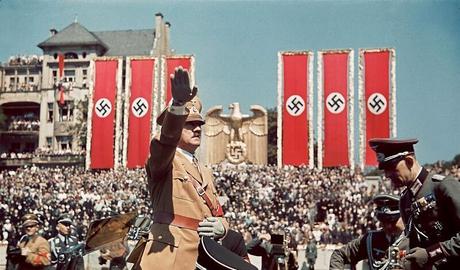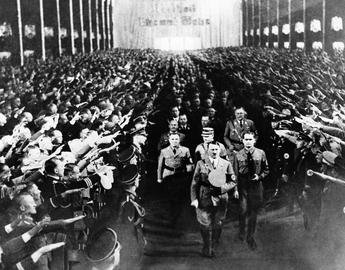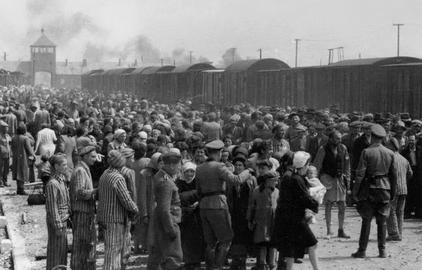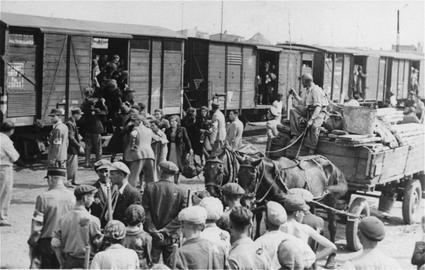“A little knowledge is a dangerous thing”. This well-known saying in the English language is well-suited to the study of history. As dangerous as outright fabrications can be, partial and selective facts can sometimes be even more misleading. A case in point is in the Nazi conception of the Aryan race and whether Nazi officials considered Iranians to be included in it. Throughout time, many misleading claims, often for politicized purposes, have been made about this question. In this article, I rely on the work of relevant scholars to show what Nazis really thought of Iranians and what they meant by the concept of the ‘Aryan’ race.
What does Aryan mean?
Like many terms and symbols used and abused by the Nazis, the term ‘Aryan’ or ‘Ariya’ has a distinct history that goes back centuries. The term was an ethnic self-designation used by various peoples in ancient India and Iran. It thus appears in sacred texts of Hinduism and Zoroastrianism that go as far back as the 2nd millennium BCE as well as inscriptions of antiquity. A notable example of the latter is an inscription found at the burial site of Dariush the Great, an ancient monarch ruling over Iran who died in 486 BC. Giving something of a biography of himself, Dariush tells the posterity that he is “an Aryan, of Aryan lineage”.
Centuries later, with the development of modern linguistics in the 18th century, scholars discovered that many languages of India, Iran and Europe had a common ancestor and could all be classified together as belonging to the Indo-European family of languages. Many languages around the world are connected together since populations have moved around in a variety of ways over centuries. But, in the decades to come, nationalist thinkers in Europe, the US, India and Iran would use this linguistic category to claim, without evidence, that “Indo-European” was actually a biological ‘race’, now often called the ‘Aryan race’. This worldview intensified in the nineteenth century, as scientific racism and sharp division of human beings into “races” became popular amongst many European thinkers. German explorer Julius Klaproth claimed “Aryans” or “Indo-Germanics” were an ancient light-skinned people while French philologist Frederic Eichhoff opined that “evidence of both physiology and linguistics” shows that all Europeans “came from the Orient”.
Racist European thinkers of the 19th century later influenced Nazi racial ideology. One of the most influential examples was Houston Stewart Chamberlain, a British-German philosopher whose popular 1899 book, The Foundation of the Nineteenth Century, was compulsory reading for teachers in Germany under Emperor Wilhelm II and later a major influence on Hitler and Nazis.
Importantly, European racists who propagated the Aryan theory often also believed that contemporary peoples of Iran and the Middle East were no longer “pure Aryans” as evident by their non-white skin. In simpler words, they did not belong to the supposedly superior race of ‘Aryans’. In mid to late nineteenth century Germany, a new version of the Aryan myth claimed that Aryan roots were actually in northern Europe. As contemporary Iranian-German historian David Motadel explains, these German thinkers believed that ‘Aryans’ had moved from Europe to Asia “and founded the ancient civilizations of the East” while “on the Asian fringes they degenerated through mixing with foreign races”. This meant that by the 20th century, “only the ‘Nordic race’, the core race in central and northern Europe, remained purely ‘Aryan’.”
Nazis and the Aryan myth
During the 1920s and 30s, the Nazis made a version of this belief in an “Aryan race” central to their ideology. In his manifesto Mein Kampf, Nazi leader Adolf Hitler called ‘Aryans’ a ‘culture-bearing race’ and claimed that they had come from northern Europe and had founded civilizations around the world but had disappeared because of mixing with others. The Nazis heavily promoted the Aryan myth as part of their propaganda that asserted ancient roots for the German people and a supposed return to stolen glory. Hitler and other German Nazis made it clear that the modern Iranians were not considered to be pure Aryans. Speaking on Iranians, Hitler would later falsely assert: “Nations which did not rid themselves of Jews, perished. One of the most famous examples of this was the downfall of a people who were once so proud – the Persians [the old European name for Iranians].”
More crudely, Hitler would tell the German army command in 1939: “We will continue to stir up unrest in the Far East and in Arabia. We must think as Masters and see in these peoples at best lacquered half-apes, who want to feel the whip.”
Top Nazi theorist Alfred Rosenberg further expounded on this separation between ancient and modern peoples of Iran. In his 1930 book, The Myth of the Twentieth Century, Rosenberg wrote that ancient Iranians were “Aryans with northern blood” but added that they had degenerated because of mixing with “lower races”.
Rosenberg wrote: “Once, the Persian king gave order to cut into the rock face of Behistun [in Iran] the following words: ‘I, Darius the Great King, King of Kings, an Aryan, having Aryan lineage’ Today the Persian muleteer [a person who drives a mule] pulls ahead soullessly by this wall: he represents thousands – culture and personality are born together with race and also die with it.”
In other words, ancient Iranians were superior “Aryans” while Iranians of today, like the “Persian muleteer” who was passing by, had lost that ancient glory by diluting their stock. As Motadel explains: “Most National Socialist ideologues agreed with the idea that ‘Aryans’ – in their attempt to cultivate the Orient – perished as a result of infiltration (Überfremdung) by ‘Semitic races’.”
Nazis in power
When the Nazis came to power in Germany in January 1933, they began to legislate on the basis of their racist worldview. A central goal of Nazi policy was exclusion and, ultimately, annihilation of Jews. As regards to people who were neither Jewish nor “Aryan”, a variety of ideas existed amongst various Nazis. While this article is focused on Iranians, many other populations, such as the Romani and Black Africans, were also considered racially inferior by the Nazis.
In 1933, a Civil Service Law, the Law for the Restroration of Professional Civil Service, was passed that limited certain rights to those Germans classified as Aryans. Defining “Aryan” for the purposes of this law, Nazi official Albert Gorter wrote: “The Aryans are… divided into the western (European), that is the German, Roman, Greek, Slav, Lett, Celt [and] Albanesen, and the eastern (Asiatic) Aryans, that is the Indian (Hindu) and Iranian (Persian, Afghan, Armenian, Georgian, Kurd).”
But many Nazis didn’t accept such an expansive concept of Aryan that included many non-Europeans. As explained above, they didn’t see the contemporary Iranians as belonging to the ‘master race’ with its supposed Nordic origins. Additionally, foreign governments such as Iran complained that the “Aryan paragraph” discriminated against their citizens. Even if the ‘paragraph’ seemed to include Iranians, Iranian students living in Germany were hardly protected. In one incident, the Iranian foreign ministry lodged a formal complaint when Nazi thugs attacked Iranian students on the streets of Berlin. As a result of domestic and foreign pressure, the Nazis went on to pass new racial laws. In November 1934, a meeting of various Nazi agencies debated the continued use of ‘Aryan’ as a legal category. Representatives of the Interior Ministry suggested that it could be simply replaced with “non-Jewish” which was less complicated. Haans Seel, from the ministry, discussed the issue in detail and argued that the term Aryan was “highly controversial and scientifically not clarified.” When the Nuremberg Race Laws were promulgated in 1935, they didn’t refer to “Aryan” but instead to “German or kindred blood” and “Jews and other non-kindred people”. The latter category now faced a slew of new restrictions; most importantly, they were stripped of their German citizenship, even decorated war veterans. These laws also banned marriage and sexual relations between “Jews and other non-kindred people” with “German or kindred blood”
Iranians and the ‘Aryan’ concept
The nineteenth-century circulation of Aryan as a racial concept wasn’t limited to Europe, and many in the nationalist Iranian intelligentsia also adopted a version of it. In trying to curry diplomatic favor with the Iranian state, Nazis would also opportunistically use the concept. In 1934, when a ceremony was held in Berlin to commemorate the 1000th birth anniversary of Iranian poet Ferdowsi, Nazi mayor Henrich Sahm pointed to the “surprising similarity” of Ferdowsi’s work with “German heroic sagas” and attributed this to common “Aryan” ancestry. Iranian diplomats would also often insist to their German counterparts that they were “Aryans” and should be considered “kindred” blood with Europeans
The government of Iran at the time had extensive relations with Germany, which predated the Nazi rise to power. Jennifer Jenkins, a historian at the University of Toronto and a leading authority on the history of Iranian-German relations in the interwar and World War II period, has argued that the basis of these relations was economic not racial-ideological. Motadel says: “The common belief that Nazi Germany enjoyed an outstanding reputation in Iran and kept strong relations with the Pahlavi government is hardly accurate” and points to the fact that many in the Iranian cabinet had pro-Allied tendencies. This was the case even before 1941 when the Anglo-Soviet invasion overthrew the Reza Shah’s government and replaced him as monarch with his son.
Still, in aiming their propaganda at Iran, the Nazis were careful to use ‘Aryan’ themes. Erwin Ettel, a German ambassador to Iran from 1939 to 1941, emphasized the use of such themes in his “general guidelines for propaganda to Iran” while he also insisted that “Germany’s battle against World Judaism” should also be directed “against the Jews in Iran, who want to force the Aryan Iranian people under their knout [yoke]”.
In 1936, as Nazi Germany prepared to host the Berlin Olympics, it tried hard to make sure as many nations as possible would attend the games. It also postponed prosecutions under the Nuremberg Race Laws until after the Games. Meanwhile, the German foreign ministry assured Egyptians they would not be excluded from the games on account of their race.
A mistaken media report led to further clarification.
In June 1936, a French newspaper reported that the Germans had decided to categorize Turks as “Aryans” while not including Egyptians, Iraqis, or Iranians in this category. This story led to a diplomatic crisis and protests by diplomats from these three countries. But the report turned out to be a hoax; in fact Nazis had merely included Turks as an “European people” which had no practical consequences since foreign citizens (so long as they were non-Jewish) were not targeted by the Nuremberg Race Laws anyway. As Motadel writes: “Berlin had… never classified an entire nation as ‘Aryan’ or ‘non-Aryan’, and indeed was very cautious in using the term ‘Aryan’ in official texts at all after 1934.”
Still, the Iranian government protested as did the governments of Iraq and Egypt. Tehran’s ambassador to Turkey contacted the German legation in Ankara and threatened diplomatic escalation while the Iranian ambassador complained at the Foreign Office in Berlin. In response, Walter Gross, head of the German Office of Racial Policy, declared that “The envoy can, on no account however, expect that the Iranians, lock, stock and barrel, be declared as Aryans.” He suggested for the issue to be settled in a verbal conversation with the Iranian ambassador. When they met the week after, the Iranian ambassador insisted to Gross that Iranians were not only a “kindred people” but “ancestors of the Aryan race”. But, as Motadel explains, “Gross was unimpressed” and Iranians were not to be officially classified as ‘Aryans’ by the Nazi regime. All Gross did was affirm that the Nuremberg Laws wouldn’t apply to marriages between non-Jewish Iranians and Germans; which was a moot point since these laws didn’t apply to non-Jewish foreign citizens anyways. The same guarantee was given to Egyptian and Iraqi governments.
“Aryan” propagandas
But while Nazis didn’t consider Iranians to be “Aryans” for domestic purposes, they were ready to use the “Aryan” myth to attempt to bring Iranians to their side during the Second World War. In the same vein, even though Hitler used extremely racist language about other non-white peoples such as Arabs and Indians, the Nazis occasionally attempted to collaborate with some nationalists from the Arab world or India when it was useful.
The Germans also helped fund pro-Nazi Iranian publications and radio broadcasts that utilized the ‘Aryan’ theme. Two examples help illustrate this strategy. Abdulrahman Seif Azad was an Iranian journalist who had lived in Germany for many years before the Nazis came to power and had published journals in various languages that promoted trade between Iran and Germany. In the 1930s, the Nazis had helped him publish a journal called Iran-Bastan (Ancient Iran) which utilized racist ‘Aryan’ themes. In 1941, he would go back to Iran to continue publishing this journal with its many racial themes. Davud Munshizade is another example. An Iranian political activist who moved to Germany in 1937, he was employed by the Nazis to start Persian-language radio propaganda broadcasting toward Iran in 1939, spreading pro-Nazi themes. In the post-war years, Munshizade returned to Iran and founded Sumka, the Iranian Nation-Socialist Party, in 1951. Sumka was explicitly modeled on the Nazi Party and, alongside other far-right groups such as the Pan-Iranist Party, it sponsored attacks on local Jews and leftists in Iran while boasting about the ‘Aryan’ race that the majority of Iranians supposedly belonged to.
Today, the ‘Aryan myth’, the idea that there is a ‘master race’ that connects peoples of Europe with those of Iran and India has been thoroughly discredited around the world. Inevitably, some Iranians, Indians and Europeans still hold on to versions of the myth of biological superiority. But, as the current article tries to show, the Nazis did not consider contemporary Iranians to belong to a superior race.
visit the accountability section
In this section of Iran Wire, you can contact the officials and launch your campaign for various problems




![Rosenberg wrote: “Once, the Persian king gave order to cut into the rock face of Behistun [in Iran] the following words: ‘I, Darius the Great King, King of Kings, an Aryan, having Aryan lineage’ Rosenberg wrote: “Once, the Persian king gave order to cut into the rock face of Behistun [in Iran] the following words: ‘I, Darius the Great King, King of Kings, an Aryan, having Aryan lineage’](https://static.prod.iranwire.com/_versions_jpg/articleslide/%D8%AF%D8%A7%D8%B1%DB%8C%D9%88%D8%B4_%DA%A9%D8%A8%DB%8C%D8%B1_HqCv__v516x270__.jpg)



















comments